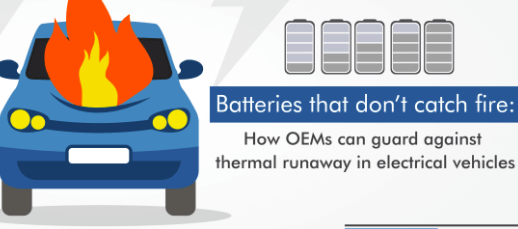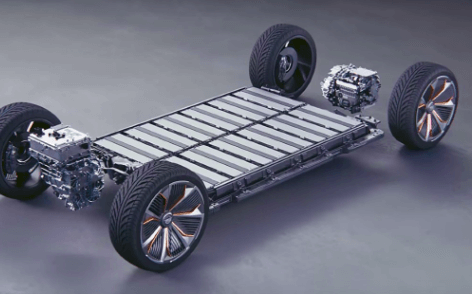
How to stop thermal runaway. What are the causes of thermal runaway?
Thermal runaway is a process that occurs in a variety of systems, including batteries, electrical components, and chemical reactions, in which the temperature of the device rises uncontrolled, causing more heating and, eventually, device failure.
The phrase is most commonly used to describe a phenomena that occurs in batteries, notably lithium-ion batteries, but it may also occur in other technologies.
Thermal runaway can have catastrophic effects, including equipment damage, injury, or a fire threat. Manufacturers utilize numerous levels of protection to prevent thermal runaway.
Thermal runaway can cause the battery to discharge enormous quantities of energy as heat, causing it to enlarge, burst, or even catch fire. Lithium-ion batteries are typically fitted with safety measures such as thermal fuses, pressure relief valves, and built-in temperature sensors that monitor the battery’s temperature and can shut it down if it becomes too hot.
Even while lithium-ion batteries are technically safer and less likely to fail now than they were a decade ago, manufacturers have yet to totally remove the problem. And the use of lithium-ion batteries has grown exponentially.
Companies are still looking for a solution with so many battery-powered items, from drones to autos.
How to stop thermal runaway.

There are numerous methods for preventing thermal runaway in lithium-ion batteries, which include:
BMS (Battery Management System):
A battery management system (BMS) monitors and manages the charging and discharging of the battery, as well as ensuring that the individual cells inside the battery remain within safe working limits. If a cell overheats, the BMS can detect it and shut down the battery to prevent thermal runaway.
TMS (Thermal Management System):
TMS aids in the dissipation of heat generated by the battery, keeping the temperature below acceptable limits. TMS can disperse heat using either active cooling techniques such as fans or liquid cooling or passive cooling methods such as thermal conductive materials.
Correct Charging:
Overcharging, which is one of the primary causes of thermal runaway, may be avoided by charging the battery properly. Overcharging and other risks can be avoided by using a charger with a built-in BMS.
Battery Construction:
Designing the battery pack with enough space between the cells and employing thermally conductive materials can assist disperse heat, lowering the danger of thermal runaway.
Software Protection:
The onboard computer software of the EV manages the charging and discharging of the battery and has the ability to shut down the system in the event of an emergency.
Maintenance on a regular basis:
Clean the battery terminals and inspect for any physical damage that might cause a short circuit and raise the danger of thermal runaway on a regular basis.
It’s vital to remember that preventing thermal runaway necessitates a combination of all of these safeguards, not just one. Thermal runaway may also be avoided with regular maintenance, careful use, and proper charging. This is How to stop thermal runaway.
Causes of thermal runaway on EVs with lithium batteries?
Under certain conditions, lithium-ion batteries, which are extensively used in electric vehicles (EVs) and other portable electronic gadgets, can experience thermal runaway. Thermal runaway is a phenomena in which the temperature within the battery rises uncontrolled, resulting in a chain reaction that leads to more heating and, eventually, battery failure.
Several causes can contribute to thermal runaway in lithium-ion batteries, including:
Overcharging:
When a lithium-ion battery is charged over its maximum capacity, it produces heat, which can result in thermal runaway.
Short-circuiting:
A short circuit can cause a large amount of current to flow through the lithium-ion battery, creating heat and causing thermal runaway.
Heat from the outside:
When exposed to high temperatures, the temperature within the lithium-ion battery can increase, resulting in thermal runaway.
Mechanical harm:
Physical damage to a lithium-ion battery can result in an internal short circuit, which can lead to thermal runaway.
Aging:
As a battery ages, its internal resistance rises and its capacity falls, increasing the danger of thermal runaway.
What are the layers of protection in a lithium battery?

To safeguard EV batteries from various sorts of harm and to extend their lifespan, numerous layers of protection are utilized. These layers are as follows:
Battery Management System (BMS)
This system is in charge of monitoring and managing the battery’s charging and discharging, as well as ensuring that the individual cells inside the battery remain within safe working limits. It is capable of detecting abnormal situations such as overcharging, overdischarging, and short-circuiting and shutting down the battery to prevent thermal runaway and other risks.
Thermal Management System (TMS):
This technology aids in the dissipation of heat generated by the battery and maintains a safe temperature. TMS can disperse heat using either active cooling techniques such as fans or liquid cooling or passive cooling methods such as thermal conductive materials.
Mechanical safeguards:
To protect the battery pack from physical harm such as impact and penetration, it is normally wrapped in a strong housing.
Electrical safety:
Overcharging, overdischarging, and short-circuiting are all prevented by fuses and circuit breakers.
Software Security:
The onboard computer software of the EV manages the charging and discharging of the battery and has the ability to shut down the system in the event of an emergency.
Electric Vehicle Coating:
Specialized coating put on the battery’s surface to protect it from external elements such as moisture, dust, and heat.
These layers of protection operate in tandem to assure the safety and longevity of the EV battery. Thermal runaway and other risks may be avoided with regular maintenance, correct use, and proper charging.
What is EV coating?

EV coating, or electro-vehicle coating, is a specialized coating that is applied to the surface of electric vehicle (EV) batteries to protect them from environmental factors such as moisture, dust, and heat. These coatings can also provide additional benefits such as improved thermal management and increased battery performance.
There are several types of EV coatings available, including:
- Thermal management coatings: These coatings are designed to dissipate heat from the battery, helping to keep the temperature within safe limits and improve battery performance.
- Moisture-proof coatings: These coatings provide a barrier that protects the battery from moisture, which can cause corrosion and damage to the battery.
- Dust-proof coatings: These coatings provide a barrier that prevents dust and other particulates from accumulating on the surface of the battery, which can cause damage and reduce performance.
- Corrosion-resistant coatings: These coatings are designed to protect the battery from corrosion caused by exposure to environmental factors such as humidity and salt.
EV coatings are typically applied using a spray or dip-coating process, and can be made from a variety of materials including polyurethane, silicone, and epoxy.
What is thermal runaway in Mosfet?
Thermal runaway in MOSFETs (Metal-Oxide-Semiconductor Field-Effect Transistor) is a phenomenon in which the temperature of the MOSFET increases uncontrollably, leading to further heating and ultimately, the failure of the device.
Thermal runaway in MOSFETs can be caused by several factors, including:
- High current: If the current flowing through the MOSFET is too high, it can generate heat that can lead to thermal runaway.
- High voltage: If the voltage applied to the MOSFET is too high, it can generate heat that can lead to thermal runaway.
- External heat: Exposure to high temperatures can cause the temperature inside the MOSFET to rise, leading to thermal runaway.
- Poor thermal management: Insufficient thermal management of the MOSFET can cause heat to build up and lead to thermal runaway.
- Aging: As the MOSFET ages, the internal resistance increases and the capacity decreases, both increasing the risk of thermal runaway.
When thermal runaway occurs in MOSFETs, the device can release large amounts of energy in the form of heat, which can cause the MOSFET to degrade or even fail. To prevent thermal runaway, manufacturers use various techniques such as proper thermal management, proper design, and proper usage of the MOSFETs.
Proper thermal management can help dissipate the heat generated by the MOSFET, reducing the risk of thermal runaway. Also, thermal sensing devices could be used to detect thermal runaway and shut down the device before it reaches critical conditions.
Related articles
- Can ev battery explode? How Long do EV battery Last?
- Advantages and Disadvantages of ev. What are the types of EVs?
- Aptera Unveils a $25,900, 1,000-Mile Electric Vehicle and Opens Pre-Orders.
- Aptera Electric Car Specifications, What is the Aptera EV’s top speed?
- Aptera online Reservation. How to reserve your Aptera EV. How much to reserve an Aptera EV?






